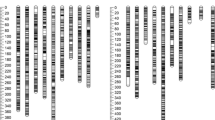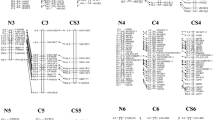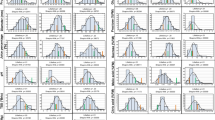Summary
Isozymes and restriction fragment length polymorphisms were used as markers in the construction of a genetic map of the citrus nuclear genome. The map was based on the segregation of 8 isozyme, 1 protein, and 37 RFLP loci in 60 progeny of a cross of two intergeneric hybrids, ‘Sacaton’ citrumelo (Citrus paradisi Macf. x Poncirus trifoliata (L.) Raf.) and ‘Troyer’ citrange (C. sinensis (L.) Osbeck x P. trifoliata), often used as rootstocks. The map contains 38 of 46 studied loci distributed on ten linkage groups. A genome size of 1,700 cM was estimated from partial linkage data. Approximately 35% of the genome should be within 10 cM and 58% within 20 cM of the mapped markers. Eight loci in three linkage groups and 1 unlinked locus deviated significantly from Mendelian segregation.
Similar content being viewed by others
References
Agarwal PK (1987) Cytogenetical investigation in Rutaceae II. Meiotic studies in three intergeneric hybrids of Citrus. Cytologia 52:757–760
Allard RW (1956) Formulas and tables to facilitate the calculation of recombination values in heredity. Hilgardia 24:235–278
Bernatzky R, Tanksley SD (1986) Majority of random cDNA clones correspond to single loci in the tomato genome. Mol Gen Genet 203:8–14
Bonierbale MW, Plaisted RL, Tanksley SD (1988) RFLP maps based on a common set of clones reveal modes of chromosomal evolution in potato and tomato. Genetics 120:1095–1103
Burr B, Evola SV, Burr FA, Beckmann JS (1983) The application of restriction fragment length polymorphism to plant breeding. In: Setlow JK, Hollaender A (eds) Genetic engineering: principles and methods, vol 5. Plenum Press, New York, pp 45–49
Cameron JW, Frost HB (1968) Genetics, breeding, and nucellar embryony. In: Reuther W, Webber HJ, Batchelor LD (eds) The citrus industry, vol 2. Univ Calif. Div Agric Sci, University of California Press, pp 325–370
Chakravarti A, Lasher LK, Reefer JE (1991) A maximum likelihood method for estimating genome length using genetic linkage data. Genetics 128:175–182
Church GM, Gilbert W (1984) Genomic sequencing. Proc Natl Acad Sci USA 81:1991–1995
Durham RE (1990) Mapping genes involved in freezing tolerance in a backcross of Citrus and Poncirus using a linkage map of isozymes and restriction fragment length polymorphisms. PhD thesis, University of Florida, Gainesville
Feinberg AP, Vogelstein B (1984) A technique for radiolabeling DNA restriction endonuclease fragments to high specific activity. Anal Biochem 137:266–267
Figdore S, Kennard W, Song K, Slocum M, Osborn T (1988) Assessment of the degree of restriction fragment length polymorphism in Brassica. Theor Appl Genet 75:833–840
Gebhardt C, Ritter E, Devener T, Schachtaschabel U, Walkemeier B, Uhrig H, Salamini F (1989) RFLP analysis and linkage mapping in Solarium tuberosum. Theor Appl Genet 78:65–75
Goldberg RB, Galau GA, Davidson RJ, Davidson EH (1973) Nonrepetitive DNA sequence representation in sea urchin embryo. Proc Natl Acad Sci USA 70:3516–3520
Gubler U, Hoffman BJ (1983) A simple and very efficient method for generating cDNA libraries. Gene 25:263–269
Guerra M dos S (1984) Cytogenetics of Rutaceae. II. Nuclear DNA content. Caryologia 37:219–226
Hanahan D (1983) Studies on transformation of Escherichia coli with plasmids. J Mol Biol 166:557–580
Havey MJ, Muehlbauer FJ (1989) Linkages between restriction fragment length, isozyme, and morphological markers in lentil. Theor Appl Genet 77:395–401
Helentjaris T (1987) A genetic linkage map for maize based on RFLPs. Trends Genet 3:217–221
Helentjaris T, Slocum M, Wright S, Schaefer A, Nienhuis J (1986) Construction of linkage maps in maize and tomato using restriction fragment length polymorphisms. Theor Appl Genet 72:761–769
Hulbert SH, Ilott TW, Legg EJ, Lincoln SE, Lander ES, Michelmore RW (1988) Genetic analysis of the fungus, Bremia lactucae, using restriction fragment length polymorphisms. Genetics 120:947–958
Iwamasa M (1966) Studies on the sterility in the genus Citrus with special reference to the seedlessness. Bull Hortic Res Stn Jpn Ser B 6:1–77
Iwamasa M, Nito N (1988) Cytogenetics and the evolution of modern citrus. In: Goren R, Mendel K (eds) Proc 6th Int Citrus Cong. Margraf Scientific Books, Weikersheim, FRG, pp 265–275
Jarrell DC (1991) A genetic map of citrus based on isozymes and RFLPs. MSc thesis, University of California, Riverside
Keim P, Diers BW, Shoemaker RC (1990) Genetic analysis of soybean hard seededness with molecular markers. Theor Appl Genet 79:465–469
Kosambi DD (1944) The estimation of map distances from recombination values. Ann Eugenics 12:172–175
Laemmli UK (1970) Cleavage of structural protein during the assembly of the head of bacteriophage T4. Nature 227:680–685
Lander ES, Green P (1987) Construction of multilocus genetic maps in humans. Proc Natl Acad Sci USA 84:2363–2367
Lander ES, Green P, Abrahamson J, Barlow A, Daly MJ, Lincoln SE, Newburg L (1987) MAPMAKER: An interactive computer package for constructing primary genetic linkage maps of experimental and natural populations. Genomics 1:174–181
Lange K, Boehnke M (1982) How many polymorphic genes will it take to span the human genome. Am J Hum Genet 32:842–845
Maniatis ET, Fritsch EF, Sambrook J (1982) Molecular cloning: a laboratory manual. Cold Spring Harbor Laboratory Press, Cold Spring Harbor, N.Y.
Martin B, Nienhuis J, King B, Schaefer A (1989) Restriction fragment length polymorphisms associated with water use efficiency in tomato. Science 243:1725–1728
McCough SR, Kodiert G, Yu ZH, Khush GS, Coffman WR, Tanksley SD (1988) Molecular mapping of rice chromosomes. Theor Appl Genet 76:815–829
Moore GA, Castle WS (1988) Morphological and isozymic analysis of open-pollinated Citrus rootstock populations. J Hered 79:59–63
Murray MG, Hoffman LM, Jarvis NP (1983) Improved yield of full-length phaseolin cDNA clones by controlling premature anti-complementary DNA synthesis. Plant Mol Biol 2:75–84
Nienhuis J, Helentjaris T, Slocum M, Ruggero B, Schaefer A (1987) Restriction fragment length polymorphism analysis of loci associated with insect resistance in tomato. Crop Sci 27:797–803
Paterson AH, Lander ES, Hewitt JD, Peterson S, Lincoln SE, Tanksley SD (1988) Resolution of quantitative traits into Mendelian factors by using a complete linkage map of restriction fragment length polymorphisms. Nature 335:721–726
Rawson JRY, Thomas K, Clegg MT (1982) Purification of total cellular DNA from a single plant. Biochem Genet 20:209–219
Reed KC, Mann DA (1985) Rapid transfer of DNA from agarose gels to nylon membranes. Nucleic Acids Res 13:7207–7221
Roose ML (1988) Isozymes and DNA restriction fragment length polymorphisms in citrus breeding and systematics. In: Goren R, Mendel K (eds) Proc 6th Int Citrus Cong. Margraf Scientific Books, Weikersheim, FRG, pp 155–165
Sarfatti M, Katan J, Fluhr R, Zamir D (1989) An RFLP marker in tomato linked to the Fusarium oxysporum resistance gene I2. Theor Appl Genet 78:755–759
Silflow CD, Hammett JR, Key JL (1979) Sequence complexity of polyadenylated ribonucleic acid from soybean suspension culture cells. Biochemistry 18:2725–2731
Soller M, Beckmann J (1983) Genetic polymorphism in varietal identification and genetic improvement. Theor Appl Genet 6:25–33
Soost RK, Cameron JW (1975) Citrus. In: Janick J, Moore JN (eds) Advances in fruit breeding. Purdue University Press, West Lafayette, Ind., pp 507–540
Soost RK, Williams TE, Torres AM (1980) Identification of nucellar and zygotic seedlings of citrus with leaf isozymes. HortScience 15:728–729
Southern EM (1975) Detection of specific sequences among DNA fragments separated by gel electrophoresis. J Mol Biol 98:503–517
Swingle WT, Reece PC (1967) The botany of Citrus and its wild relatives. In: Reuther W, Webber HJ, Batchelor LD (eds) The citrus industry, vol 1, revised edn. Div Agric Sci, University of California, Berkeley, pp 190–430
Tanksley SD (1983) Molecular markers in plant breeding. Plant Mol Biol Rep 1:3–8
Tanksley SD, Hewitt J (1988) Use of molecular markers in breeding for soluble solids content in tomato — a re-examination. Theor Appl Genet 75:811–823
Tanksley SD, Rick C (1980) Isozymic gene linkage map of the tomato: application in genetics and breeding. Theor Appl Genet 57:161–170
Tanksley SD, Medina-Filho H, Rick C (1982) Use of naturally occurring enzyme variation to detect and map genes controlling quantitative traits in an interspecific backcross of tomato. Heredity 49:11–25
Tanksley SD, Bernatzky R, Lapitan NL, Prince JP (1988) Conservation of gene repertoire but not gene order in pepper and tomato. Proc Natl Acad Sci USA 85:6419–6423
Torres AM (1983) Fruit trees. In: Tanksley SD, Orton TJ (eds) Isozymes in plant genetics and breeding. Elsevier Scientific, Amsterdam, pp 401–421
Torres AM, Soost RK, Mau-Lastovicka T (1982) Citrus isozymes: genetics and distinguishing nucellar from zygotic seedlings. J Hered 73:335–339
Torres AM, Mau-Lastovicka T, Williams TE, Soost RK (1985) Segregation distortion and linkage of Citrus and Poncirus isozyme genes. J Hered 76:289–294
Xiang C, Roose ML (1988) Frequency and characteristics of nucellar and zygotic seedlings in 12 citrus rootstocks. Sci Hortic 37:47–59
Young ND, Tanksley SD (1989) RFLP analysis of the size of chromosomal segments retained around the Tm-2 locus of tomato during backcross breeding. Theor Appl Genet 77:353–359
Author information
Authors and Affiliations
Additional information
Communicated by F. Salamini
Rights and permissions
About this article
Cite this article
Jarrell, D.C., Roose, M.L., Traugh, S.N. et al. A genetic map of citrus based on the segregation of isozymes and RFLPs in an intergeneric cross. Theoret. Appl. Genetics 84, 49–56 (1992). https://doi.org/10.1007/BF00223980
Received:
Accepted:
Issue Date:
DOI: https://doi.org/10.1007/BF00223980




